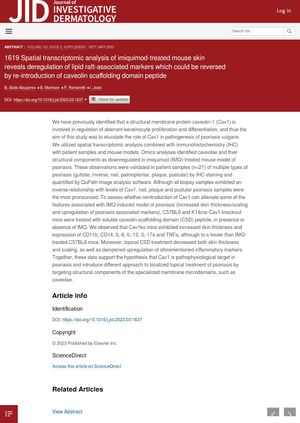Spatial Transcriptomic Analysis of Imiquimod-Treated Mouse Skin Reveals Deregulation of Lipid Raft-Associated Markers Reversible by Caveolin Scaffolding Domain Peptide
April 2023
in “
Journal of Investigative Dermatology
”

TLDR The research found that a protein called caveolin-1 is reduced in psoriasis, but reintroducing it can help alleviate some psoriasis symptoms.
The study investigated the role of a structural membrane protein, caveolin-1 (Cav1), in the pathogenesis of psoriasis vulgaris. Using spatial transcriptomic analysis and immunohistochemistry (IHC) with patient samples (n=21) and mouse models, the researchers found that caveolae and their structural components were downregulated in an imiquimod (IMQ)-treated mouse model of psoriasis. This was validated in patient samples of multiple types of psoriasis. The study also found that reintroduction of Cav1 via soluble caveolin scaffolding domain (CSD) peptide treatment could alleviate some features associated with IMQ-induced psoriasis, such as increased skin thickness/scaling and upregulation of psoriasis-associated markers. These findings suggest that Cav1 could be a target in psoriasis treatment and introduce a different approach to localized topical treatment of psoriasis by targeting structural components of specialized membrane microdomains, such as caveolae.



